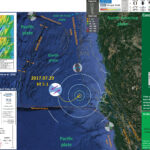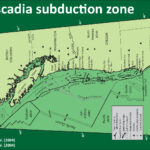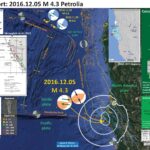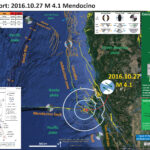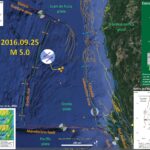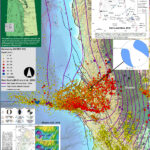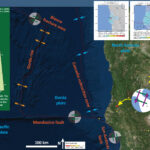We just had an earthquake in the Gorda plate. The USGS magnitude is 5.1. This earthquake happened a few kilometers southwest of the 2014 M 6.8 earthquake. Based upon the orientation of the faults in the region, today’s earthquake may…
Earthquake Report: Trinidad, California
Early this morning, I was awakened by a mild jolt. I thought, well, seems like a M 3+- nearby. I did not get out of bed. The main shaking lasted a couple of seconds, though it seemed that there was…
Earthquake Report: 1700 Cascadia subduction zone 317 year commemoration
Today (possibly tonight at about 9 PM) is the birthday of the last known Cascadia subduction zone (CSZ) earthquake. There is some evidence that there have been more recent CSZ earthquakes (e.g. late 19th century in southern OR / northern…
Earthquake Report: 2016 Summary Cascadia
Here I summarize the seismicity for Cascadia in 2016. I limit this summary to earthquakes with magnitude greater than or equal to M 4.0. I reported on all but five of these earthquakes. I put this together a couple weeks…
Earthquake Report: Mendocino fault!
I was awake and just logging into my laptop, still in bed, when I first felt some movement. The movement was slight and not impulsive, so I thought it was a small earthquake. Then the shaking reappeared. This is when…
Earthquake Report: Petrolia (CA)
This morning there was a good shaker that was widely felt across the region. I did not feel it. I was probably driving at the time, or grading papers, which can have the same sense-deadening effect. Here is the USGS…
Earthquake Report: Mendocino fault!
Yesterday there was an earthquake along the eastern extension of the Mendocino fault system. This magnitude M = 4.1 earthquake (here is the USGS website for this earthquake) is a small magnitude, but it was widely felt. I was in…
Earthquake Report: Gorda Plate!
Last night, while I was preparing an online exam for my students to take while I am at the Geological Society of America Annual Meeting in Denver Colorado, there were a couple earthquakes in the Gorda plate offshore of northern…
Earthquake Report: Bayside (northern California): Update #1
So, I put together another map with today’s earthquake in context with the historic seismicity and some other factors. Now the USGS magnitude is M = 4.7 and there is a moment tensor for this earthquake (that looks very similar…
Earthquake Report: Bayside (northern California)
Well, after installing a stilling basin for our new tide gage installation at Trinidad, CA, I was napping in my upstairs bedroom in Manila, CA. I was awakened by a short (2-3 second) short shaking earthquake. Turns out it was…
